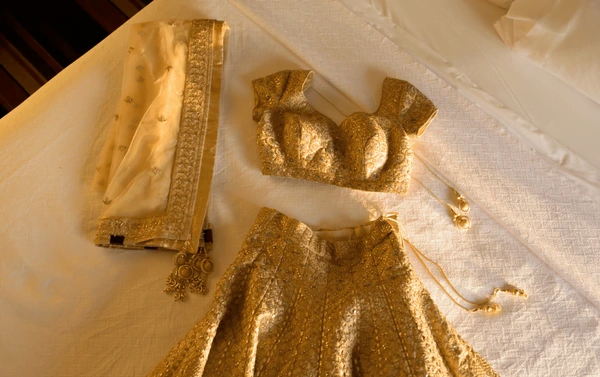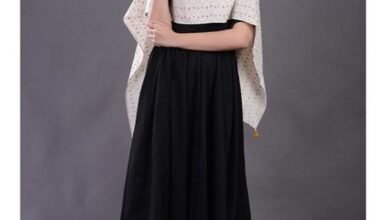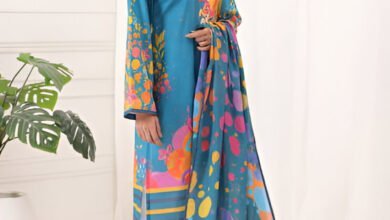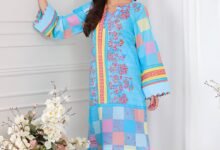Top Golden Bridal Dupatta Styles for Your Big Day

The rich history of the golden bridal dupatta
And holds a favorite place in South Asian matrimonial customs. This goes beyond beauty but is the representation of several centuries of culture and change. In ancient India, gold was only used in clothing for kings and queens as a symbol of wealth, prosperity and divine benevolence.

Over time, this became conventional in wedding clothes which reflect the grandeur and luxury associated with weddings. Through the ages, from Vedic period to Mughal era; dupatta has been worked upon in gold threads getting it different styles and designs that depict tastes for various dynasties and regions.
Double Dupatta Lehenga: Create a Stunning Look
Cultural Symbolism of the Golden Bridal Dupatta
The golden bridal dupatta is replete with cultural symbolism and meanings. During Hindu marriages, it is put over the bride’s head during kanyadaan ritual as an expression for purity, humility as well as god’s blessings For Sikh brides, it stands for spiritual unity between herself with groom accepting him as her life companion during Anand Karaj service performed by a priest.
Muslim Nikah ceremonies have an important position for such materials because women pass from one stage into another wearing them. Yellow is believed to be particularly auspicious color that brings wealth good luck and happiness to newlyweds.

Diverse Styles and Variations
Golden bridal dupattas come in numerous styles capturing the unique cultures and regional influences experienced within South Asia. Banarasi Dupattas are known for their heavy texture combined with intricate zari work done on them using gold thread which makes them have flowery motifs borrowed from Mughal art works or paisleys .
The Kanjeevaram Dupatta from Tamil Nadu is made out of luxurious silk embedded with colorful gold patterns consisting peacocks or temple borders. Phulkari dupatta which are traditional embroidery works in Punjab heavily use colored threads together with golden elements resulting into lively designs hence captivating attention.
Chanderi dupattas from Madhya Pradesh are famous for their lightweight texture and a subtle grace with which they are characterized by delicate gold zari work. Bandhani Dupatta is dyed and tie-dye, resulting in patterns that are dyed using such colors and textures as well as gold details to make it look more traditional and festive.

Craftsmanship and Techniques
The making of the golden bridal dupatta requires painstaking craftsmanship and ancient techniques. Zari work is one of the most common features in such dupattas which involve weaving fine golden threads into the fabric to form complex patterns or designs. This technique has its roots back in ancient India hence it needs great skill and accuracy.
It takes artisans several months to design each individual dupatta making sure that everything is perfect about it. The other types of embroidery used on these garments including Phulkari, Kanjeevaram weaving, Bandhani add to their beauty apart from zari. Diverse nationalities have diverse traditions of this kind; hence numerous styles exist among these yellow clothes meant for wedding ceremonies today.
CURRENT DEVELOPMENTS IN GOLDEN WEDDING SCARFS
The modern brides are coming up with new ideas which redefine the golden wedding dupatta by adding their personal touches and contemporary trends. Embroidery can be made according to the specifications of the bride such as initials, dates or symbols that are meaningful to her.
These lightweight and fashionable dupattas are made from a fusion of fabrics combining traditional gold zari work with materials like tulle, organza and georgette. Minimalist designs with a little hint of gold appeal to simple brides who would rather have their wedding dress remain unadorned. In addition, different colors of threads can be used in order to give this golden dupatta a more vibrant look; for instance one can use red or green floral patterns at the edges.

Also, there is a trend that we call multipurpose dupatta, it’s fashion was designed for a number of functions or events.
STYLING TRENDS IN GOLDEN BRIDAL SCARFS
To achieve an overall fabulous appearance with this attire, there are various ways through which the golden bridal dupatta can be styled. Classic head draping is a way in which bride ties this piece of material on her head using pins creating that traditional look as well as gracefulness associated with wearing a veil on her wedding day.
Meanwhile double draping enhances volume and makes layers without sacrificing luxurious fabric while considering when dressing bride regally.But side swept drapes create asymmetrical looks due to being pinned at one shoulder and other end dangled down at opposite hip.
The lehenga skirt should be covered by tying both ends together; on one part you should place it around abdomen while the other is thrown over your shoulder.With veil style draping where it cascades all over from backside up till covering entire face.Veil style draping is also called ‘Fairy Tale Dupatta’.

Maintenance and Preservation
Taking care of a golden bridal dupatta requires attention to details. Proper washing and storage are important in maintaining the life of the fragile cloth and complex needlework. It is recommended that brides keep their dupattas in a place where it is cool, dark and dry to avoid fading as well as destruction from moistness.
To maintain the dupatta in its original condition especially for those which have been passed down through generations, professional cleaning can be done. The use of special acid-free tissue paper prevents dust and other physical damages to the dupatta when kept in boxes or bags specially made for this purpose. In this way, brides will save these golden bridal dupattas so that they will not get them easily.

The Future of the Golden Bridal Dupatta
The golden bridal dupatta has continued evolving with changing fashion trends as well as cultural influences. As traditional bridal wears continue to be affected by global fashion, there might be more fusion styled dupattas which combine contemporary designs inspired by traditional craftsmanship.
Thus, the tension between retaining custom while embracing new trends requires close scrutiny among ladies about their concerns over modern beauty tastes as related to acknowledgement of their customs during marriages .
Changes in fabric technology and embroidery methods will also shape future developments surrounding this type of wedding shawl-making material such as motifs, patterns, etc.Due to its timeless elegance and cultural significance across generation-to-generation periods however, it is very unlikely that this aspect could ever stop being a part of South Asian bride’s attire.











